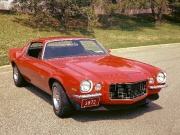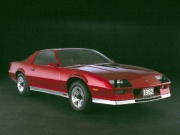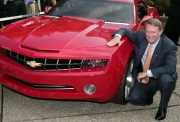Main Page
|
Welcome to CamaroWiki!
Welcome to the Camaro Wiki page. Brought to you from the most kick ass Camaro site on the Internet, CamaroZ28.COM and the Kings of Camaro, Chris Frezza and Jason Debler. The Chevrolet Camaro is a popular pony car made in North America by the Chevrolet Motor Division of General Motors. It was introduced on September 29, 1966; the start of the 1967 model year as a competitor to the Ford Mustang. The car shared the same platform and major components with the Pontiac Firebird, also introduced in 1967. Four distinct generations of the car were produced before production ended in 2002. A new Camaro is expected to roll off assembly lines in late 2009 for the 2010 model year. |
Origin
According to some within General Motors, a 4-seat sports car was designed in the late 50's for a growing America which would be the Turbo-charged Corvair Spyder of 1962. Additionally, Chevrolet unveiled the "Super Nova" at the New York Autoshow in March of 1964, a matter of weeks prior to Ford unveiling the Mustang. While the Corvair was restyled in the fall of 1964 and the Turbocharged Spyder was renamed "Corsa," within 6 months, the sales figures for Mustang convinced GM that the "pony car" market was more than just a flash in the pan.
Work became more intense on a program called the "XP-836", a four seat sporty-type coupe that would share an all-new platform with the 1968 Nova X-body. This new car was referred to as the "Panther" or "F-body." It would be the first GM car where computers were used extensively in the development process. The idea behind the car that would become "Camaro" was to offer a great-looking sporty car that attracted attention, no matter where it went. It would have the incredible performance attributes of the legendary Chevrolet small-block V8 and was said to be "the closest thing to a 'Vette, yet!". Additionally, the car must ride smoothly, but handle like a European sports car. It must allow the individual to tailor the car to his or her needs and wants, both from a performance and appearance standpoint, and it must do all of this at a Chevrolet price. You will agree that these brand attributes have been kept for 35 years.
According to documents dated June 10, 1966, and exhaustive search was conducted for appropriate names starting with the letter "C." It should also be noted that at that time in Chevy's history, all of the car lines started with the letter "C". Chevrolet, Chevelle, Chevy II, Corvair and Corvette. Bel Air, Impala, Malibu, etc were models within the car lines. This letter designation stayed true until the fall of 1969 when the 1970 Monte Carlo was introduced.
A short list was developed from a list of over 2,200 words starting with "C", and then an even more massive search was done to ensure that the name picked would not have any negative connotation.
One word really stood out from the others..."Camaro."
In Heath's New French and English Dictionary dated 1932, the word "Camaro" is defined as "Comrade, Friend, Mate, Chum, or Pal." Thus, the name "Camaro" was chosen and blessed by then-General Manager Elliot M. "Pete" Estes, who would later become President of General Motors. When announcing the Camaro to the press worldwide, Mr. Estes had this to say about the name: "Chevrolet has chosen a name which is lithe and graceful....in keeping with our other car names beginning with 'C.' It suggests comradeship of good friends, as a personal car should be to its owner."
And so it was, and on September 29, 1966, the Camaro roared to life in thousands of Chevy dealerships nationwide.
From a personal perspective, we often wonder if Mr. Estes had any inkling that the Camaro would go on to become an American Icon with a 35 year history, and that the car would forge untold numbers of friendships; pals or comrades, if you will.
First generation
The first-generation Chevrolet Camaro debuted for the 1967 model year on an all brand new rear-wheel drive GM F-body platform and would be available as a 2-doors, 2+2 seating, coupe or convertible with a choice of inline-6 and V8 engine powerplants. The first-gen Camaro would last up through the 1969 model year.
Second generation
Introduced to market in February of 1970, the second-generation Chevrolet Camaro would be in production for a total of 12 years. The car grew somewhat larger and wider with the new styling; this resulted in a heavier car as well. Still based on the F-body platform, the new Camaro was engineered much like its predecessor in that it still used a unibody structure with a front subframe, leaf springs in the back and A-arms up front for suspension. The car would see major changes in both styling and performance as time progressed from the introduction through the end of second-generation production in 1981.
Third generation
The third-generation Chevrolet Camaro was introduced for the 1982 model year. It continued to use General Motors' F-body platform and would produce a "20th Anniversary Commemorative Edition" for 1987 and "25th Anniversary Heritage Edition" for 1992. These were also the first Camaros with factory fuel injection, four-speed automatic transmissions, five-speed manual transmissions, four-cylinder engines, 16-inch wheels, and hatchback bodies.
The third-gen Camaros would continue through the 1992 model year. When introduced in 1982 there were two body styles for the Camaro, Sport Coupe and Z28. Sport Coupe came standard with a four cylinder engine with 2.8L V6 optional. Z28 had ground effects and a carborated 5.0 liter V8. It was in 1985 that the third generation got serious with performance. The IROC - Z was introduced. An acronym for International Race of Champions, the car was loaded with race and performance minded features. Larger rims shod with p245-50ZR Goodyear Gator-back unidirectional tires were standard on the IROC. Powering this gem was a 5.0 liter 215hp version of the Corvette's 5.7 liter Tuned Port Injection. The car was a head turner and quick for the day. Zero to sixty times around 6.9 seconds were not uncommon. The biggest drawback was that the most powerful engine could only be mated to a four speed automatic transmission. For 1986 there was a detuning for corporate average fuel economy regulations that maxed power output at 190hp. That would all be fixed in 1987 with the introduction of the 5.7 liter Corvette engine pumping out 225 hp. Never again would a top line factory spec Mustang be a performance match for the top line factory spec Camaro (except in sales).
Fourth generation
The fourth-generation Chevrolet Camaro debuted for the 1993 model year on an updated F-body platform. It would retain the same characteristic since the first-generation's introduction back in 1967; 2-doors, 2+2 seating, available as a coupé or convertible, rear-wheel drive, and a choice of V6 and V8 powerplants. It featured the 5.7 L (350 cid) LT1 V8 engine that had been introduced in the Corvette one year earlier, as well as an optional six-speed manual transmission. The 1998 model year was refreshed and revised with both exterior and engine changes. Replacing the LT1 was GM's all-new 5.7 L (346 cid) LS1 which had been introduced with the Chevrolet Corvette C5.
The fourth-gen Camaro would last up through the 2002 model year, at which point production of the F-Body platform went on hiatus.
Fifth generation
On January 9, 2006, the first official word regarding a fifth-generation Camaro from General Motors came at the 2006 North American International Auto Show, where the 2006 Camaro Concept was released. The concept is powered by the 400 hp LS2 V8 and equipped with the T-56 six-speed manual transmission. GM will also show the 2007 Camaro Convertible Concept on January 6, 2007 at the 2007 North American International Auto Show. Other than the convertible top, Hugger Orange pearl tri-coat paint job, and a pair of dark gray racing stripes, the convertible concept is exactly the same as the coupe concept.
On 10 August, 2006, GM Chairman and CEO Rick Wagoner announced that GM will build an all-new version of the Chevrolet Camaro muscle car based on the award-winning concept that debuted at the Detroit auto show. The all-new Camaro will begin with early production versions at the end of 2008 and will go on sale in the first quarter of 2009. The Camaro Convertible is expected to go into production about a year later. The Camaro will be rear wheel drive, have an independent rear suspension, be offered with both V6 and V8 engines, and have available automatic and manual transmissions. Pricing has not been officially announced.
External links
- CamaroZ28.COM
- Chevrolet Camaro Concept official Chevrolet site
- 2009 production annoucement official GM press release
Disclaimer:
Camaro and all of the related names, titles, and slogans are copyrighted and trademarked to General Motors. Camarowiki is not in any way associated with General Motors or Chevrolet Motor Division.



